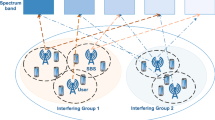Abstract
This paper considers a distributed interference avoidance problem employing frequency assignment in the Gaussian interference channel (IC). We divide the common channel into several sub-channels and each user chooses one sub-channel for transmission in such a way that the total interference in the IC is minimum. This mechanism named interference avoidance in this paper can be modeled as a competitive game model. And a completely autonomous distributed iterative algorithm called distributed interference avoidance algorithm (DIA) is adopted to achieve the Nash equilibrium (NE) of the game. Due to the self-optimum, the DIA is a sub-optimal algorithm. Therefore, through introducing an optimal compensation (or price) into the competitive game model, we successfully develop a compensation-based game model to approximate the optimal interference avoidance problem. Moreover, an optimal algorithm called iterative optimal interference avoidance algorithm (IOIA) is proposed to reach the optimality of the interference avoidance scheme. We analyze the implementation complexity of the proposed algorithm which is only O(N), with N standing for the number of users in the IC. We also give the proof on the convergence of the proposed algorithm. The performance upper bound and lower bound are derived for the IOIA algorithm. The simulation results show that the IOIA does reach the optimality under the condition of interference avoidance mechanism.
Similar content being viewed by others
References
Carleial A B. A case where intereference does not reduce capacity. IEEE Trans Inf Theory, 1975, 21: 569–570
Han T S, Kobayashi K. A new achievable rate region for the interference channel. IEEE Trans Inf Theory, 1981, 27: 49–60
Sason I. On achievable rate regions for the Gaussian interference channel. IEEE Trans Inf Theory, 2004, 50: 1345–1356
Leshem A, Zehavi E. Cooperative game theory and the Gaussian interference channel. IEEE J Sel Areas Commun, 2008, 26: 1078–1088
Laufer A, Leshem A. Distributed coordination of spectrum and the prisoner’s dilemma. In: Proceedings of first IEEE International Symposium on New Frontiers in Dynamic Spectrum Access Networks, Baltimore, 2005. 94–100
Laufer A, Leshem A, Messer H. Game theoretic aspects of distributed spectral coordination with application to DSL networks [EB/OL]. http://arxiv.org/pdf/cs/0602014, 2006
Suris J E, DaSilva L A, Han Z, et al. Cooperative game theory for distributed spectrum sharing. In: Proceedings of IEEE International Conference on Commun, Glasgow, 2007. 5282–8287
Yu W, Ginis G, Cioffi J M. Distributed multiuser power control for digital subscriber lines. IEEE J Sel Areas Commun, 2002, 20: 1105–1115
Cendrillon R, Moonen M, Verliden J, et al. Optimal multi-user spectrum management for digital subscriber lines. In: Proceedings IEEE International Conference on Commun, Paris, 2004. 1–5
Cendrillon R, Huang J, Mung C. Autonomous spectrum balancing for digital subscriber lines. IEEE Trans Signal Process, 2007, 55: 4241–4257
Huang J, Cendrillon R, Mung C. Autonomous spectrum balancing (ASB) for frequency selective interference channels. In: Proceedings of IEEE International Symposium on Information Theory. Seattle, 2006. 610–614
Tsiaflakis P, Diehl M, Moonen M. Distributed spectrum management algorithms for multiuser DSL networks. IEEE Trans Signal Process, 2008, 56: 4825–4843
Etkin R, Parekh A, Tse D. Spectrum sharing for unlicensed bands. IEEE J Sel Areas Commun, 2007, 25: 517–528
Saraydar C U, Mandayam N B, Goodman D. Efficient power control via pricing in wireless data networks. IEEE Trans Commun, 2002, 50: 291–303
Huang J, Berry R A, Honig M L. Distributed interference compensation for wireless networks. IEEE J Sel Areas Commun, 2006, 24: 1074–1084
Wang F, Krunz M, Cui S. Price-based spectrum management in cognitive radio networks. IEEE J Sel Top Signal Process, 2008, 2: 74–87
Su Y, Schaar M. A new look at multi-user power control games. In: Proceedings of IEEE International Conference on Communications, Beijing, 2008. 1072–1076
Su Y, Schaar M. A new perspective on multi-user power control games in interference channels [EB/OL]. http://arxiv.org/pdf/0709.3880, 2008
Babadi B, Tarokh V. Distributed dynamic frequency allocation in wireless networks under time-varying user activities. In: Proceedings of IEEE Sarnoff Symposium, Princeton, 2008. 1–5
Chen J K, Veciana G, Rappaport T S. Improved measurement-based frequency allocation algorithms for wireless networks. In: Proceedings of IEEE Global Telecommunications Conference, Washington DC, 2007. 4790–4795
Babadi B, Tarokh V. A distributed dynamic frequency allocation algorithm [EB/OL]. http://arxiv.org/pdf/0711.3247v2, 2008
Author information
Authors and Affiliations
Corresponding author
Rights and permissions
About this article
Cite this article
Jing, Z., Bai, B. & Ma, X. Price-based interference avoidance game in the Gaussian interference channel. Sci. China Inf. Sci. 55, 301–311 (2012). https://doi.org/10.1007/s11432-011-4280-1
Received:
Accepted:
Published:
Issue Date:
DOI: https://doi.org/10.1007/s11432-011-4280-1




